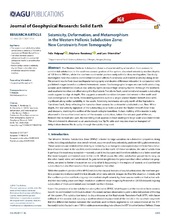| dc.contributor.author | Halpaap, Felix | |
| dc.contributor.author | Rondenay, Stéphane | |
| dc.contributor.author | Ottemöller, Lars | |
| dc.date.accessioned | 2019-02-20T17:49:00Z | |
| dc.date.available | 2019-02-20T17:49:00Z | |
| dc.date.issued | 2018-02-23 | |
| dc.Published | Halpaap F, Rondenay S, Ottemöller L. Seismicity, Deformation, and Metamorphism in the Western Hellenic Subduction Zone: New Constraints From Tomography. Journal of Geophysical Research - Solid Earth. 2018;123(4):3000-3026 | eng |
| dc.identifier.issn | 2169-9356 | en_US |
| dc.identifier.issn | 2169-9313 | en_US |
| dc.identifier.uri | https://hdl.handle.net/1956/19128 | |
| dc.description.abstract | The Western Hellenic Subduction Zone is characterized by a transition from oceanic to continental subduction. In the southern oceanic portion of the system, abundant seismicity reaches depths of 100 km to 190 km, while the northern continental portion rarely exhibits deep earthquakes. Our study investigates how this oceanic‐continental transition affects fluid release and related seismicity along strike. We present results from local earthquake tomography and double‐difference relocation in conjunction with published images based on scattered teleseismic waves. Our tomographic images recover both subducting oceanic and continental crusts as low‐velocity layers on top of high‐velocity mantle. Although the northern and southern trenches are offset along the Kephalonia Transform Fault, continental and oceanic subducting crusts appear to align at depth. This suggests a smooth transition between slab retreat in the south and slab convergence in the north. Relocated hypocenters outline a single‐planed Wadati‐Benioff Zone with significant along‐strike variability in the south. Seismicity terminates abruptly north of the Kephalonia Transform Fault, likely reflecting the transition from oceanic to continental subducted crust. Near 90 km depth, the low‐velocity signature of the subducting crust fades out and the Wadati‐Benioff Zone thins and steepens, marking the outline of the basalt‐eclogite transition. Subarc melting of the mantle is only observed in the southernmost sector of the oceanic subduction, below the volcanic part of the arc. Beneath the nonvolcanic part, the overriding crust appears to have undergone large‐scale silica enrichment. This enrichment is observed as an anomalously low Vp/Vs ratio and requires massive transport of dehydration‐derived fluids updip through the subducting crust. | en_US |
| dc.language.iso | eng | eng |
| dc.publisher | American Geophysical Union | en_US |
| dc.rights | Attribution CC BY-NC-ND | eng |
| dc.rights.uri | http://creativecommons.org/licenses/by-nc-nd/4.0/ | eng |
| dc.subject | subduction zone | eng |
| dc.subject | intermediate depth seismicity | eng |
| dc.subject | local earthquake tomography | eng |
| dc.subject | Greece | eng |
| dc.title | Seismicity, Deformation, and Metamorphism in the Western Hellenic Subduction Zone: New Constraints From Tomography | en_US |
| dc.type | Peer reviewed | |
| dc.type | Journal article | |
| dc.date.updated | 2018-09-06T14:57:00Z | |
| dc.description.version | publishedVersion | en_US |
| dc.rights.holder | Copyright 2018 The Authors | en_US |
| dc.identifier.doi | https://doi.org/10.1002/2017jb015154 | |
| dc.identifier.cristin | 1607418 | |
| dc.source.journal | Journal of Geophysical Research - Solid Earth | |

